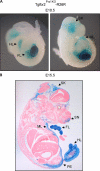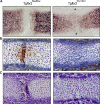TGF-beta signaling is essential for joint morphogenesis
- PMID: 17576802
- PMCID: PMC2064369
- DOI: 10.1083/jcb.200611031
TGF-beta signaling is essential for joint morphogenesis
Abstract
Despite its clinical significance, joint morphogenesis is still an obscure process. In this study, we determine the role of transforming growth factor beta (TGF-beta) signaling in mice lacking the TGF-beta type II receptor gene (Tgfbr2) in their limbs (Tgfbr2(PRX-1KO)). In Tgfbr2(PRX-1KO) mice, the loss of TGF-beta responsiveness resulted in the absence of interphalangeal joints. The Tgfbr2(Prx1KO) joint phenotype is similar to that in patients with symphalangism (SYM1-OMIM185800). By generating a Tgfbr2-green fluorescent protein-beta-GEO-bacterial artificial chromosome beta-galactosidase reporter transgenic mouse and by in situ hybridization and immunofluorescence, we determined that Tgfbr2 is highly and specifically expressed in developing joints. We demonstrated that in Tgfbr2(PRX-1KO) mice, the failure of joint interzone development resulted from an aberrant persistence of differentiated chondrocytes and failure of Jagged-1 expression. We found that TGF-beta receptor II signaling regulates Noggin, Wnt9a, and growth and differentiation factor-5 joint morphogenic gene expressions. In Tgfbr2(PRX-1KO) growth plates adjacent to interphalangeal joints, Indian hedgehog expression is increased, whereas Collagen 10 expression decreased. We propose a model for joint development in which TGF-beta signaling represents a means of entry to initiate the process.
Figures










Similar articles
-
Joint TGF-β type II receptor-expressing cells: ontogeny and characterization as joint progenitors.Stem Cells Dev. 2013 May 1;22(9):1342-59. doi: 10.1089/scd.2012.0207. Epub 2013 Feb 15. Stem Cells Dev. 2013. PMID: 23231014 Free PMC article.
-
TGF-β type II receptor/MCP-5 axis: at the crossroad between joint and growth plate development.Dev Cell. 2012 Jul 17;23(1):71-81. doi: 10.1016/j.devcel.2012.05.004. Dev Cell. 2012. PMID: 22814601 Free PMC article.
-
Transforming growth factor-β signaling in myogenic cells regulates vascular morphogenesis, differentiation, and matrix synthesis.Arterioscler Thromb Vasc Biol. 2012 Jan;32(1):e1-11. doi: 10.1161/ATVBAHA.111.238410. Epub 2011 Oct 6. Arterioscler Thromb Vasc Biol. 2012. PMID: 21979435
-
An emerging complexity of receptors for transforming growth factor-beta.Princess Takamatsu Symp. 1994;24:264-75. Princess Takamatsu Symp. 1994. PMID: 8983081 Review.
-
Transforming growth factor-beta in cardiac ontogeny and adaptation.Circ Res. 1993 Nov;73(5):783-91. doi: 10.1161/01.res.73.5.783. Circ Res. 1993. PMID: 8403249 Review.
Cited by
-
Joint TGF-β type II receptor-expressing cells: ontogeny and characterization as joint progenitors.Stem Cells Dev. 2013 May 1;22(9):1342-59. doi: 10.1089/scd.2012.0207. Epub 2013 Feb 15. Stem Cells Dev. 2013. PMID: 23231014 Free PMC article.
-
Articular cartilage and joint development from embryogenesis to adulthood.Semin Cell Dev Biol. 2017 Feb;62:50-56. doi: 10.1016/j.semcdb.2016.10.005. Epub 2016 Oct 20. Semin Cell Dev Biol. 2017. PMID: 27771363 Free PMC article. Review.
-
RAB23 regulates musculoskeletal development and patterning.Front Cell Dev Biol. 2023 Feb 23;11:1049131. doi: 10.3389/fcell.2023.1049131. eCollection 2023. Front Cell Dev Biol. 2023. PMID: 36910145 Free PMC article.
-
Effect of transforming growth factor-β2 on biological regulation of multilayer primary chondrocyte culture.Cell Tissue Bank. 2018 Dec;19(4):763-775. doi: 10.1007/s10561-018-9732-z. Epub 2018 Oct 30. Cell Tissue Bank. 2018. PMID: 30377863 Free PMC article.
-
Tendon-to-bone attachment: from development to maturity.Birth Defects Res C Embryo Today. 2014 Mar;102(1):101-12. doi: 10.1002/bdrc.21056. Birth Defects Res C Embryo Today. 2014. PMID: 24677726 Free PMC article. Review.
References
-
- Ando, K., S. Kanazawa, T. Tetsuka, S. Ohta, X. Jiang, T. Tada, M. Kobayashi, N. Matsui, and T. Okamoto. 2003. Induction of Notch signaling by tumor necrosis factor in rheumatoid synovial fibroblasts. Oncogene. 22:7796–7803. - PubMed
-
- Archer, C.W., G.P. Dowthwaite, and P. Francis-West. 2003. Development of synovial joints. Birth Defects Res. C. Embryo Today. 69:144–155. - PubMed
-
- Baffi, M.O., E. Slattery, P. Sohn, H.L. Moses, A. Chytil, and R. Serra. 2004. Conditional deletion of the TGF-beta type II receptor in Col2a expressing cells results in defects in the axial skeleton without alterations in chondrocyte differentiation or embryonic development of long bones. Dev. Biol. 276:124–142. - PubMed
-
- Bhowmick, N.A., A. Chytil, D. Plieth, A.E. Gorska, N. Dumont, S. Shappell, M.K. Washington, E.G. Neilson, and H.L. Moses. 2004. TGF-beta signaling in fibroblasts modulates the oncogenic potential of adjacent epithelia. Science. 303:848–851. - PubMed
Publication types
MeSH terms
Substances
Grants and funding
LinkOut - more resources
Full Text Sources
Other Literature Sources
Molecular Biology Databases

